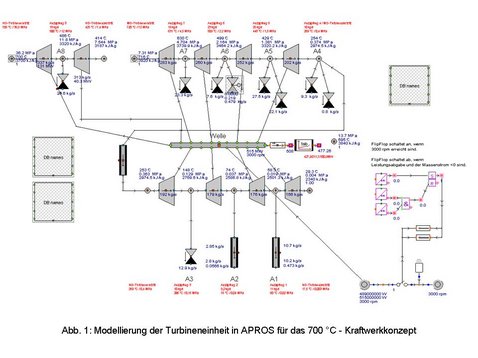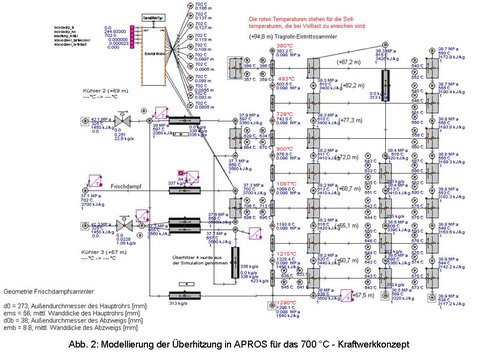Dynamic behavior of 700 °C power plants
Project Objective
Similarly high standards as those of conventional power plants also apply to high-temperature power plants. However, high-temperature facilities exhaust considerably more components, which means the impact of dynamic operations must be observed particularly closely. In the framework of the KW 21 Phase II- research project (BY5DE), a program for the simulation of the dynamic of a 700°C coal block should be developed, in order to create control specifications, calculate the lifetime consumption of accidents, and to test the overall design. So far, the optimization of the power plants has been largely in terms of given stationary operating points, with a technical-economical optimum in mind. For the load cycling operation of the presently existing power plants, the control system requirements are proceeding on the safe side, so that acceptable temperature transients and stresses in critical components are not overseen. The project should yield results that will allow for the operational costs of a 700°C power plant to be determined and optimized. The efficiency levels of the start-up and shut-down phases, as well as operation during disturbances, should be included in the simulation. At the same time, the exhaustion of selected thick-walled components should be taken into account throughout the experiment. The effects of flue gas imbalances on the overheated sections, as well as a model for heat surface pollution should be integrated. The framework conditions for these two influential factors should be simulated in a 3-D CFD-Model of a steam generator.
Methods
The foundation for the one dimensional dynamic simulation provides a dynamic internal model of a coal block. This model, developed with APROS, will be accordingly altered to portray the behavior of the 700°C power plant. Further, the steam generator of the 700°C power plant concept should be modeled by means of CFD, in order to determine the framework conditions for heat surface pollution and flue gas imbalances. Subsequently, the coupling of these two models for the simulation of the effects of heating imbalances, steam side multi-strandedness and heat surface pollution on the dynamics and lifetime consumption will follow. In order to attain the strengths necessary for the corresponding fresh gas parameters, new materials in the field of convective heat surfaces-above all nickel-base alloys- will be employed. For this, the nickel-base alloys available on the market must be more closely examined to determine their individual suitability as materials. Further, the material costs, strength and S/N curves of the critical components must be determined, in order to complete the depletion calculation following the relevant rules, as well as the economic assessment. In order to economically optimize power plant efficiency independently of framework conditions (baseline market prices, primary and secondary balancing energy...), the dynamic simulation should be paired with a basic algorithm.
For more information
KW21-Website: Link

